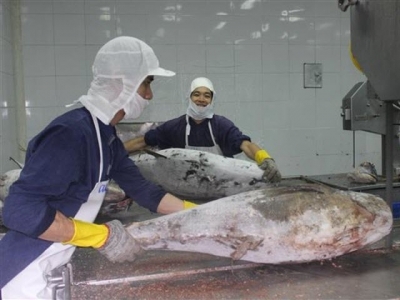Need to build brand for export seafood

On 12/6, at the conference of the Association of Seafood Exporters and Producers of Vietnam (VASEP), Deputy Minister of Agriculture and Rural Development Tran Thanh Nam, recommended that it needs to build brand names for export shrimp and pangasius.
The source of seafood is a major concern of export enterprises. Photo: T.H
Difficulties in processing materials
According to the seafood enterprises, in 2018, there are some factors that continue to affect by actually stopping seafood exports, such as the US catfish inspection program; Anti-dumping duty on shrimp and pangasius; "Yellow card" of IUU; and an internal problem with the raw material for processing seafood exports being unstable; The problem of antibiotic impurities in the raw materials has decreased but still exists, and the problem of traceability… is still in the process of improvement.
As for raw materials for processing seafood export, businesses think that there are still many difficulties. Due to market fluctuations and the forecasted result of raw materials for seafood processing, there is always lack of accuracy, leading to the imbalance of supply and demand. Besides that, climate change, salt infiltration and epidemics also cause shortages of fishery materials.
Mrs. Truong Thi Le Khanh, Chairman of Vinh Hoan Corporation, said that the Pangasius industry has been growing hot in prices of raw materials for more than 20 years. Fish farmers are very concerned when raw material prices are not stable. High prices have attracted the attention of the neighboring countries, impacting on processing and exporting Pangasius.
The businesses worry that the high price of Pangasius might cause importing countries to replace Pangasius with other fish. The increase in price of catfish has the potential of raw material instability. To overcome this situation, the Pangasius companies should sit back to identify the hazards to have specific solutions, a basis to ensure sustainable sources of raw materials for processing for export.
Mr Nguyen Hong Minh, former Deputy Minister of Fisheries, said that in order to limit the pumping of impurities into shrimp, it is necessary to form a shrimp market, specifying all shrimp materials must be traded through markets, aquaculture. New approaches to management of new smart devices are limited for ending the pumping of impurities into shrimp, as well as the use of antibiotics banned in aquaculture.
The inability to take the initiative in the production of raw materials, means the import of raw materials for feed production has affected the cost of aquaculture raw materials, making Vietnamese seafood less competitive and dependent on the rise and fall of prices.
Ensure traceability
According to the evaluation of seafood enterprises, the modern trend that many countries in the world are implementing is to strengthen the control chain production, traceability, focus on the pre-processing stage.
At present, the control of quality and safety of export seafood in Vietnam is not sufficient to control the production of raw materials such as: seed quality, use of chemicals, prohibited antibiotics during culture, as well as impure injection.
The export is risky in the context of importing countries like America, Japan and EU are increasingly strengthening and tightening the food safety and hygiene.
Mrs Thu Sac, a representative of the Seafood Committee (VASEP), said that the yellow card for Vietnam was a challenge, but also a great opportunity for Vietnam's seafood industry to gain many advantages. Fishing at sea has changed fundamentally in catching and processing aquatic materials to overcome the "yellow card" and get the "green card" back.
At the conference, Deputy Minister of Agriculture and Rural Development Tran Thanh Nam, said that the source of raw materials for processing seafood is one of the issues they are interested in for processing and exporting seafood. With its role, VASEP needs to strengthen its relationship with international trade associations to protect the legitimate interests of Vietnamese seafood enterprises by having quality inspection departments to reduce costs for enterprises.
For seafood enterprises, it is necessary to focus on improving competitiveness and improving the quality of processed products. To build a safe raw material area by strengthening the link between production and aquaculture to develop the raw material area, ensuring the harmony between the parties involved in aquaculture, processing and export. At the same time, the establishment of auction floor fisheries, so as to solve the root source of raw materials.
"In particular, if we want to export sustainable seafood we must develop the brand. At present, Vietnam has successfully built the export brand of rice, while for the two main fishery products that are shrimp and Pangasius, it is necessary to promote the construction and development of the brand for these two main export items." Chief Tran Thanh Nam emphasized
Related news
 Nghe An invests in VietGAP standard shrimp breeding area
Nghe An invests in VietGAP standard shrimp breeding area Quynh Luu district has the biggest shrimp breeding area in Nghe An with total area of 75 hectares. The locality is pushing forward to broaden shrimp breeding
 Prospects bright for seafood exports to ASEAN
Prospects bright for seafood exports to ASEAN ASEAN has been the largest trading partner of Vietnam and one of its Top 10 seafood export markets over the last 20 years
 ASEAN the next big fish for Vietnam’s seafood industry
ASEAN the next big fish for Vietnam’s seafood industry Current focus is on the ‘Big 4’ – the US, China, Japan and South Korea, but this could change.